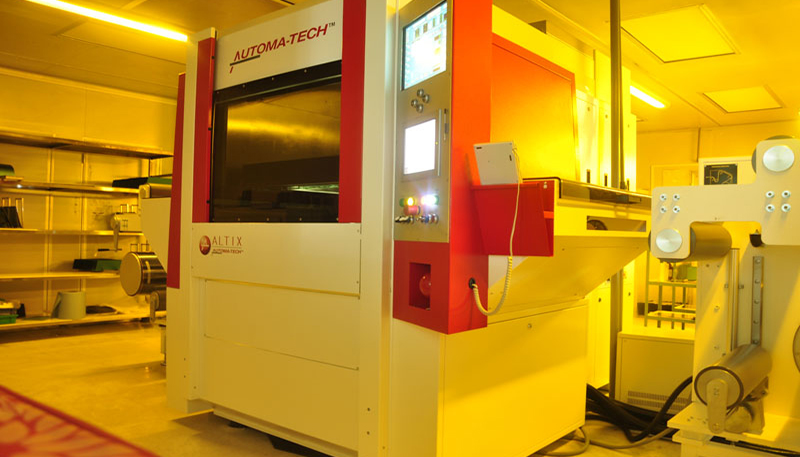
Chemical etching is a precise and effective process used to create intricate designs, patterns, or markings on stainless steel and other metals. A chemical etching machine for stainless steel is specifically designed to facilitate this process by applying a controlled chemical reaction that removes selected areas of material from the metal surface. This technique is widely used in various industries, such as electronics, automotive, aerospace, and jewelry, because it produces high-quality, repeatable results. This article will cover how chemical etching machines work, their components, advantages, applications, and safety considerations.
Chemical etching machines for stainless steel utilize a combination of chemicals and temperature control to achieve precision etching on the metal surface. The basic process involves coating the metal with a resist or mask that protects certain areas from being etched. Then, the machine applies an etchant solution, typically an acid or other chemical compound, to remove unmasked areas. The resist protects certain parts of the metal, allowing the etchant to selectively remove material only from the uncoated areas.
The process can be automated or manual, with most modern machines offering automation features that increase accuracy and efficiency. The etching depth, pattern precision, and speed are controlled by adjusting factors such as etchant concentration, temperature, and exposure time. For more intricate designs, photochemical etching techniques are used, where a light-sensitive photoresist is applied to the metal surface and exposed to UV light through a patterned mask.
Etchant Tank: The tank holds the chemical etching solution, which is critical for the etching process. The size and material of the tank are chosen based on the type of metal and the scale of operation.
Heating System: Temperature plays a crucial role in the speed and quality of etching. Heating elements ensure the etchant is at an optimal temperature, which improves reaction rates and helps achieve consistent results.
Pumps and Agitation Mechanism: Some machines have pumps and agitation mechanisms to ensure even distribution of the etchant solution over the metal surface, which results in uniform etching.
Masking or Resist Application: The resist or mask is essential in defining the areas that will be etched. Machines may have features for automatic application of the mask using UV-sensitive resists in photochemical etching or other coating methods for simpler etching jobs.
Conveyor Belt or Table: For high-volume production, many machines are equipped with conveyor belts or tables that move the metal parts through the etching chamber, increasing efficiency in the etching process.
Control Panel: Modern etching machines come with control panels that allow operators to set and monitor parameters like temperature, exposure time, and etchant flow rate. This control is crucial for consistency, especially in high-precision industries.
Precision and Detail: Chemical etching can create intricate designs and patterns on stainless steel with minimal deviation, making it ideal for industries requiring high precision.
Non-Thermal Process: Unlike other metalworking methods like laser cutting, chemical etching does not produce heat, meaning there is no thermal distortion. This is particularly beneficial for thin metals or parts that need to maintain specific tolerances.
Versatility: Chemical etching works on a variety of metals, not just stainless steel, and can be used for both large production runs and small custom jobs. It is also effective for both surface marking and deep etching.
Cost-Effectiveness for Complex Patterns: For complex and detailed patterns, chemical etching is often more cost-effective than mechanical methods because it does not require expensive tooling or die changes.
Environmentally Friendly Options: Many modern chemical etching machines use safer, less toxic etchants and recycle chemical solutions, reducing environmental impact.
Electronics: In electronics, Stainless steel etching is used for circuit boards, RF shields, and EMI (electromagnetic interference) shielding. It is crucial for high-precision, thin components.
Automotive and Aerospace: These industries utilize etching for components like fuel injector parts, washers, gaskets, and decorative elements on dashboards or control panels.
Medical Devices: Stainless steel is widely used in medical devices for its corrosion resistance and biocompatibility. Chemical etching creates precise, burr-free edges for surgical instruments and implants.
Jewelry and Decorative Arts: Stainless steel is often etched for decorative items, allowing for unique textures, patterns, and designs on jewelry, plaques, and other decorative products.
Industrial and Tooling: Etching is also used for industrial tools, parts marking, and branding of equipment where stainless steel is the material of choice.
Using a chemical etching machine for stainless steel requires careful handling due to the chemicals involved. Safety measures should include:
Proper Ventilation: Adequate ventilation prevents the buildup of fumes from the etchant solution.
Protective Gear: Operators should wear protective equipment such as gloves, goggles, and aprons to prevent skin and eye contact with corrosive chemicals.
Regular Maintenance: Routine cleaning and maintenance of the machine and its components (e.g., pumps, heating elements, and control systems) ensure smooth operation and longevity.
Safe Disposal: Disposal of etching solutions should follow environmental guidelines, as improper disposal can harm the environment.
Chemical etching machines for stainless steel are essential for industries requiring high precision and intricate patterns. These machines are versatile and efficient, with applications spanning electronics, automotive, medical, and decorative fields. While the process requires careful handling due to the chemicals involved, advancements in machine technology and safety protocols have made it safer and more environmentally friendly. With the right equipment, chemical etching is a powerful tool for achieving high-quality finishes on stainless steel, combining aesthetics and functionality in a cost-effective way.
Contact: andy_Lai
Phone: 18938693450
E-mail: yw9@zldsmt.com
Add: Building A3, Huafa Industrial Park, Fuyong Town, Fuyuan Road, Fuyong Town, Baoan District, Shenzhen,China